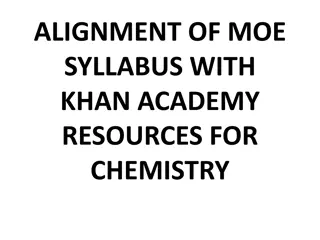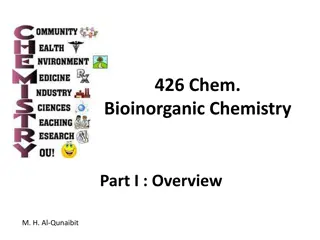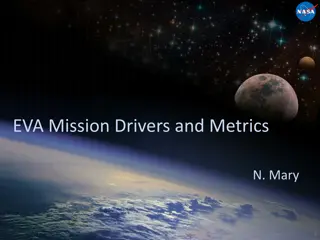Funded Tropospheric Chemistry Mission Parameters Overview
Funded tropospheric chemistry missions like Europe Sentinel 4, USA TEMPO, Korea GEMS, and others aim to monitor atmospheric composition for air quality assessment. The missions involve advanced instruments to measure ozone, nitrogen dioxide, sulfur dioxide, aerosols, and more, with specific spatial sampling and resolution requirements. Collaboration efforts under the Air Quality Constellation focus on harmonizing data products and improving quality through sharing standards and advocating open data policies. Recommendations include applying best practices for UV-Vis spectrometer calibration and developing common post-launch calibration/validation strategies.
Download Presentation

Please find below an Image/Link to download the presentation.
The content on the website is provided AS IS for your information and personal use only. It may not be sold, licensed, or shared on other websites without obtaining consent from the author.If you encounter any issues during the download, it is possible that the publisher has removed the file from their server.
You are allowed to download the files provided on this website for personal or commercial use, subject to the condition that they are used lawfully. All files are the property of their respective owners.
The content on the website is provided AS IS for your information and personal use only. It may not be sold, licensed, or shared on other websites without obtaining consent from the author.
E N D
Presentation Transcript
Funded tropospheric chemistry mission parameters (as of 4/2015) Europe Sentinel 4 USA TEMPO Korea GEMS Europe Sentinel 5 Precursor TROPOMI Geostationary Geostationary Geostationary Low-Earth Orbit Europe and surrounding North America Asia-Pacific Global Domain 1 hour 1 hour 1 hour 1 day Revisit Detailed Design, Phase C Instrument CDR July 2015 Instrument CDR complete Instrument delivery 2015 Status 2021 (Flight Acceptance Review first instrument) No earlier than 11/2018 No later than 11/2021 2019 Early 2016 Launch UV-Vis-NIR 305-500, 750-775 nm UV-Vis 290-490, 540-740 nm UV-Vis 300-500 nm UV-Vis-NIR-SWIR 270-500, 675-775, 2305- 2385 nm Payload O3, trop. O3, NO2, SO2, HCHO, AAI, AOD, height- resolved aerosol O3, trop. O3, 0-2km O3, NO2, HCHO, SO2, CHOCHO, AOD, AAI O3, NO2, SO2, HCHO, AOD O3, NO2, SO2, HCHO, AAI, AOD, height-resolved aerosol, CO, CH4 7 km x 7 km nadir Products 8 km x 8 km at 45N 3.5 km N/S x 8 km E/W @38N Spatial Sampling 2.22 km N/S x 5.15 km E/W @35N 8.9 km N/S x 11.7 km E/W @40N 8.88 km N/S x 5.15 km E/W @35N 7 km N/S x 8 km E/W @38N (gas), 3.5 km N/S x 8 km E/W @38N (aerosol) 7 km x 7 km nadir Nominal product resolution Two instruments in sequence on MTG-S; use TIR sounder on MTG-S (expected sensitivity to O3 and CO). Synergy with imager on MTG-I w.r.t. aerosol and clouds. GEO-CAPE precursor or initial component of GEO-CAPE. Synergy with AMI and GOCI-2 instruments w.r.t. aerosol and clouds. In formation with S-NPP for synergy w.r.t. clouds and O3. Notes Synergy with GOES-R/S ABI w.r.t. aerosol and 1 3rdTEMPO Science Team Meeting, 27-28 May 2015 clouds.
Air Quality Constellation Targets: Harmonization to improve data product quality and usage During 2013, the CEOS* ACC** AQ Constellation leads developed recommendations for harmonization to mutually improve data quality and facilitate widespread use of the data products (see next slide) Includes LEO and GEO: LEO observations are a common transfer standard to link the GEO observations Progress to date includes: Sharing of instrument requirements influenced instrument specifications, which may facilitate harmonization of data products Advocating open data policy (including L1B) with common formats to facilitate broad usage Sharing L1B and L2 format specifications to easily exchange data Establishment of new GSICS UV-Vis subgroup AQ Constellation Geophysical Validation Needs document is in preparation *CEOS = Committee on Earth Observation Satellites **ACC = Atmospheric Composition Constellation 2 3rdTEMPO Science Team Meeting, 27-28 May 2015
Open Data Policy and Common Cal/Val Standards: Recommendations 1. Apply best practices (lessons learned) for UV-Vis spectrometer calibration, characterization, and validation Share calibration/characterization plans and invite cross participation in reviews of such plans Develop longer term recommendations for common post-launch cal/val strategies (e.g. supersite instrumentation round-robins, joint airborne campaigns) 2. Radiometric consistency Pre-launch: highest priority is per-instrument calibration/characterization as completely as possible (common absolute radiance calibration is secondary) Post-launch: more work needed on approaches (eg LEO vicarious intercalibration or Earth scenes) 3. Sharing and consistency of data products (format, content, metadata) Share specification documents Share instrument characterization/calibration databases and Level 1-b data, in a common format, to allow wide application of algorithms to all datasets Identify and produce common constellation data products (may differ from standard products) 4. Consistency in retrieval algorithms Cross participation in ATBD reviews Jointly improve retrieval algorithms by conducting inter-comparisons on common radiances 5. Consistency of spectroscopy 6. Support scientific collaboration 3 3rdTEMPO Science Team Meeting, 27-28 May 2015
Geophysical Validation Needs document outline Thanks to Ben Veihelmann & Jean-Christopher Lambert for initial draft Identification of Common Parameters in L1b and L2 Products Lessons Learned from LEO heritage missions Common Geophysical Validation Needs (by mission phase) Inter-Mission Geophysical Validation Needs (by mission phase) Development Needs for New Validation Infrastructure or Approaches 4 3rdTEMPO Science Team Meeting, 27-28 May 2015
Action Items & Recommendations from 4/2015 CEOS ACC-11 Meeting (1 of 2) Complete the GEO Geophysical Validation Needs (GV) document Draft 1 in 6 Months, Finalisation 6 months prior to GEMS and TEMPO instrument deliveries, May 2017 Test flow of 1 case-study product e.g. Trop NO2 Check status/need to address GMAP-ASIA, Chinese FY4 Address DSCVR Agree to an initial subset of constellation products, and target performance requirements (timeframe? After individual mission L2 processing is defined) Identify aspects that require harmonization, report on status at next CEOS meeting Identification of possible additional GV infrastructure / standards needed to demonstrate/achieve intermission consistency Assess feasibility of an Air Quality Data-Quality Traceability Framework (e.g., the ESA QA4ECV currently in progress) Expect update (case study for NO2) at ACC-12 5 3rdTEMPO Science Team Meeting, 27-28 May 2015
Action Items & Recommendations from 4/2015 CEOS ACC-11 Meeting (2 of 2) ACTION: ALL to Evaluate adoption of data file conventions as being implemented by S-5P team as an AC missions convention P. Veefkind to provide current S5P format specs to CEOS-ACC Involve relevant teams at the respective agencies Goal to select/endorse convention at ACC-12 meeting Formulate meta-data guidelines sufficiently open for AC missions Hold next OSSE workshop (preferably at ECMWF, TBC) Explore feasibility of extending measurements from KORUS-AQ ground sites to overlap with S-5P initial operations. (POCs at NIER and NASA) By S5PVTeam workshop Begin planning/advocacy for a post-launch integrated geophysical validation (GV) campaign Pan-mission GV infrastructure Collaborative planning and implementation of an around-the-world airborne + ground+ modeling campaign 6 3rdTEMPO Science Team Meeting, 27-28 May 2015
Level 2 Products: Potential Constellation Products (as of 4/2015) Potential common products include the standard products common to all missions Europe Sentinel 4 USA TEMPO Korea GEMS Europe Sentinel 5 Precursor TROPOMI Tropospheric O3 Total O3 Standard Standard Possible Standard Standard Standard Standard Standard Total NO2 Standard Possible Standard? Standard Tropospheric NO2 Tropospheric H2CO Total SO2 Standard Standard Standard? Standard Standard Standard Standard Standard Standard Likely Standard Standard AOD Standard Likely Standard Standard 7 3rdTEMPO Science Team Meeting, 27-28 May 2015
Level 2 Products: Potential Constellation Products (as of 4/2015) Challenges for common constellation products Differing instrument specifications Differing fields of regard and viewing geometries => direct inter-calibration and inter-validation of L1b is not possible Differing radiometric performance Differing native horizontal resolutions (spatial representativeness) Differing retrieval algorithms Different approaches in standard algorithms Probably different methods for total/troposphere separation Differences in standard cloud/aerosol screening (e.g., S-4 & S-5P will make use of NIR) TEMPO Trop O3 will make use of visible band Etc. Etc. What products, to what accuracies (precisions?), validated how? 8 3rdTEMPO Science Team Meeting, 27-28 May 2015
Summary: Ongoing Activities Data harmonization activities are underway Mission leads have been sharing specifications Pre-launch instrument characterization requirements necessarily vary by instrument GSICS UV-Vis working group is off to a good start AQ Constellation Geophysical Validation Document is being prepared with the goal of guiding mission specific requirements being developed by the respective agencies Next step: identify goals/approaches for common constellation products and their validation Past and upcoming airborne field campaigns offer potential for ongoing collaborative GEO mission preparation and possibly early S-5P cal/val AROMAT Romania 2015, 2016 (ESA) KORUS-AQ Korea 2016 (Korea NIER, US NASA) An AQ Constellation session has been proposed for the Dec 2015 Fall AGU Meeting, to include all aspects of preparation 9 3rdTEMPO Science Team Meeting, 27-28 May 2015























